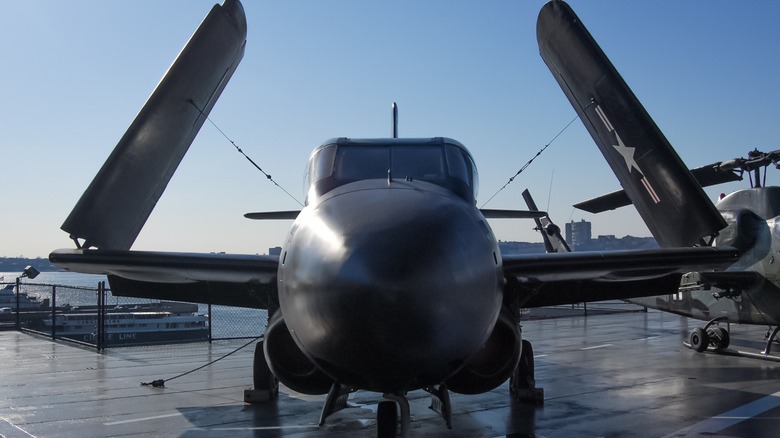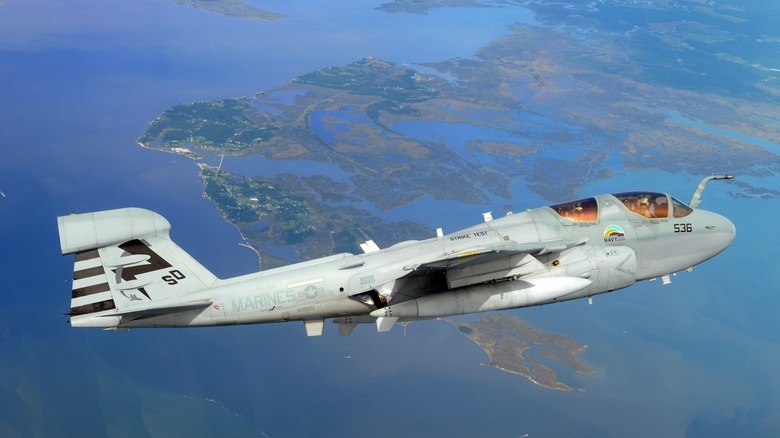Everything To Know About The Douglas F-10, F3D Skyknight Jet
When it comes to the best military jets in the world, American defense contractors like Boeing, Lockheed Martin, and the Douglas Aircraft Company are among the top manufacturers of advanced military aircraft ever produced. Though fighter jets like the F-15 or controversial F-35 Lightning II are well-known today, none of those designs would exist without the pioneers who developed jet-engine technology during its infancy during the 1950s and '60s.
The F3D Skyknight — later redesignated the Douglas F-10 — is one airplane that helped the United States win skirmishes at night during the Korean and Vietnam Wars. It would be the first jet-propelled aircraft designed and manufactured to specifically perform night missions and would go on to support U.S. bombers under the cover of darkness for over a decade.
The F-10 Skyknight would be just one of the many night-fighter designs attempted immediately after WWII for the United States Air Force (USAF) and United States Navy (USN). Other night fighters developed at this time include the Curtiss F-87 Blackhawk, F-89 Scorpion, and the Northrop Grumman F9F.
Unlike the F-87 Blackhawk, however, the Skynight was reliably used in several combat missions and served the U.S. Armed Forces in research roles into the 1980s. However, it wasn't without its problems.
The F-10 Skynight was the first jet-propelled night fighter to take flight
The United States Navy granted a contract to Douglas in April of 1946 to develop three prototype night fighters designated as XF3D-1. Ed Heinemann at Douglas led the design team, and two years later, on March 23, 1948, the XF3D-1 would take its first flight, becoming the first jet-propelled aircraft built specifically for night missions to enter production for the United States military.
Though the USAF Curtiss F-87 Blackhawk was officially the first night fighter to take flight for the Department of Defense, that plane would prove to be underpowered. After multiple production and development delays, the Blackhawk was scraped by the USAF in October of that year in favor of the Northrop F-89 Scorpion.
Initially, the first 28 F3D Skyknight production jets were underpowered, equipped with two Westinghouse J34 jet engines. Later, a design for an F3D upgraded with two higher-powered Westinghouse J46 turbojet engines and a wing-swept design was proposed but never saw the day of light. Instead, the Navy settled with upgraded J34s, forever underpowering the Skyknight.
The Douglas Skyknight was different
In addition to the jet engines, the two-crew F3D Skyknight came with a side-by-side cabin for the pilot and radar operator rather than the traditional configuration of one pilot sitting in front of the other. The jet had no bombing capabilities but was equipped with four fixed 20mm cannons and an AN/APQ-35 search and target radar mounted to the jet's nose for effective nighttime targeting, though that's not what made the Skyknight's design so peculiar.
Unlike typical military jet ejection, where the canopy over the cockpit jettisons and the pilots are propelled up and over the craft, the Skyknight had an escape chute fitted behind the crew and angled 40 degrees down between the engine bays. Instead of ejecting up and out, the ejection system blew off the bottom portion of the hatch; then, the pilots would have to rotate their chairs and slide feet first out of the chute.
Several Skyknight jet variations were produced over the years, including the original XF3D-1 prototypes, the F3D-1, and the F3D-2. With 268 total craft manufactured by the end of production, most of the ones utilized by the Navy were the F3D-2 variants.
The F-10 Skyknight had one major problem
The F3D-1 Skyknight would officially enter service in February 1951, but in addition to being underpowered, it also had one major issue. In 1952, an F3D-1 was lost during routine operations, and obvious cracks started to show for what was supposed to be the Navy's night-based carrier fighter.
According to accounts of the time by Navy pilots, the Skyknight would sit idle for 15–20 minutes, and during that time, the immense heat from the jet engines would bake the wood on the flight deck and cause fires on carriers from oil spills. When pilots attempted to position the planes so that the exhausts extended over the flight deck, life rafts and fire hoses were burnt and destroyed.
Eventually, though the twin-jet engine F-10 Skynight was originally designed to be a carrier-based jet, it would eventually be repurposed to be a shore-based escort and night fighter as the Navy and Marines opted for smaller carrier aircraft instead. In this new role as a shore-based escort, the Skynight would become an important part of America's attack capabilities during the Korean and Vietnam Wars.
The F-10 Skynight was a success in combat
Once the Navy and Marines realized that the F3D Skyknight was better suited for shore-based night missions rather than being a carrier-based plane, it was fairly successful in helping escort bombers in Vietnam and Korea. However, it also proved its air-to-air fighter prowess when, in November 1952, an F3D-2 piloted by Marine Major William T. Stratton Jr. and Master Sergeant Hans C. Hogland made the first jet-to-jet kill at night when they shot down a North Korean Yak-15.
Later in the Korean War, F3Ds would successfully escort B-29s in nighttime bombing raids over North Korea. During the conflict, Skyknights flown by the Marines were credited with six kills. The F3D would also be used extensively in the Vietnam War beginning in 1965, though, by this time, 35 of the aircraft still in use had been modified with electronic reconnaissance and countermeasures and were redesignated the EF-10B, or F-10.
In 1970, the last Skyknights were officially retired from service and replaced with the Northrop Grumman EA-6A Intruder, then the EA-6B Prowler. Today, the U.S. Navy utilizes the EA-18G Growler as a successor to what interestingly became what we know today as airborne electronic attack aircraft.




